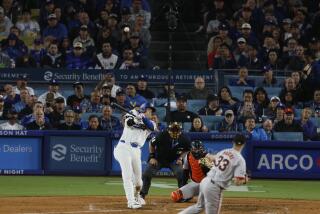Securities Certificates Gain Popularity
- Share via
Question: I heard that collectors of stock and bond certificates took a real beating a few years ago when the value of their collections fell sharply. I have several old certificates that are probably worth more for their signatures and art value than for any monetary reason. I wonder if this collectible was worth pursuing on a serious level in light of the recent gyrations.--L.P.
Answer: Scripophily, the collecting of old stock and bond certificates, is a relatively new area of collecting--begun on an organized basis in the mid-1970s--and does not have much of a history that would allow us to analyze price swings for you. Activity in this collectible appeared to take off in Europe as a result of scholarly attempts to catalogue bonds issued particularly by Russia and China at the turn of the century.
Then some stamp dealers entered the picture, and something of a market was formed for old share certificates thought to be more valuable as a collectible rather than for any intrinsic financial value they might still have. As you might guess, it didn’t take long for auction houses to get a piece of the action, and prices of certificates began to take off--unfortunately to levels far beyond their collectible value.
The fall came in the late 1970s. A combination of reasons apparently led to the dive: too much speculation; a large decrease in the level of inflation that had artificially driven up their value as investors sought an inflation hedge for excess cash, and--an old economic axiom--too many sellers and not enough buyers (or, in this case, collectors).
Now the pendulum appears to have swung the other way. More collectors have been attracted to the field, prices have become more realistic and the cataloguing of shares has become more precise. As this collectible becomes more popular, we suspect that prices should assume more realistic levels.
Q: I have a baseball card with a typographical error on it. How valuable does this make the card?--N.M.
A: Simply because there is a printing error on the card does not automatically cause its value to skyrocket. For example, it’s possible that a number--or, indeed, all--of the cards of a particular player were printed with the error. This would dilute the value of the card you hold. Check with dealers, collectors or price catalogues before making an assumption on value.
Baseball-card errors have taken many different forms over the years--including the wrong picture of the player described on the card and incorrect biographical information.
One area in which baseball cards do appear to have increased significantly in value is in the card showing the player in his rookie--or first--year in the major leagues. A prime example would be Pete Rose’s rookie-year baseball card because Rose is in the national spotlight as he bears down on Ty Cobb’s all-time base-hit record.
Other superstar rookie cards have sold for significant sums so Rose’s should be no different.
The All-American Collectors Show at the Glendale Civic Auditorium has always been fun and informative, and this year’s 15th edition should be no different.
The show is scheduled for Saturday, noon-7 p.m., and Sunday, 10 a.m.-4 p.m., with $3 general admission; children younger than 12 pay $1. More than 225 dealers will be selling everything from a $1 Cracker Jacks “coin” to a $25,000 cigar-store Indian. There will also be displays ranging from antique toys to advertising memorabilia.
More to Read
Inside the business of entertainment
The Wide Shot brings you news, analysis and insights on everything from streaming wars to production — and what it all means for the future.
You may occasionally receive promotional content from the Los Angeles Times.










